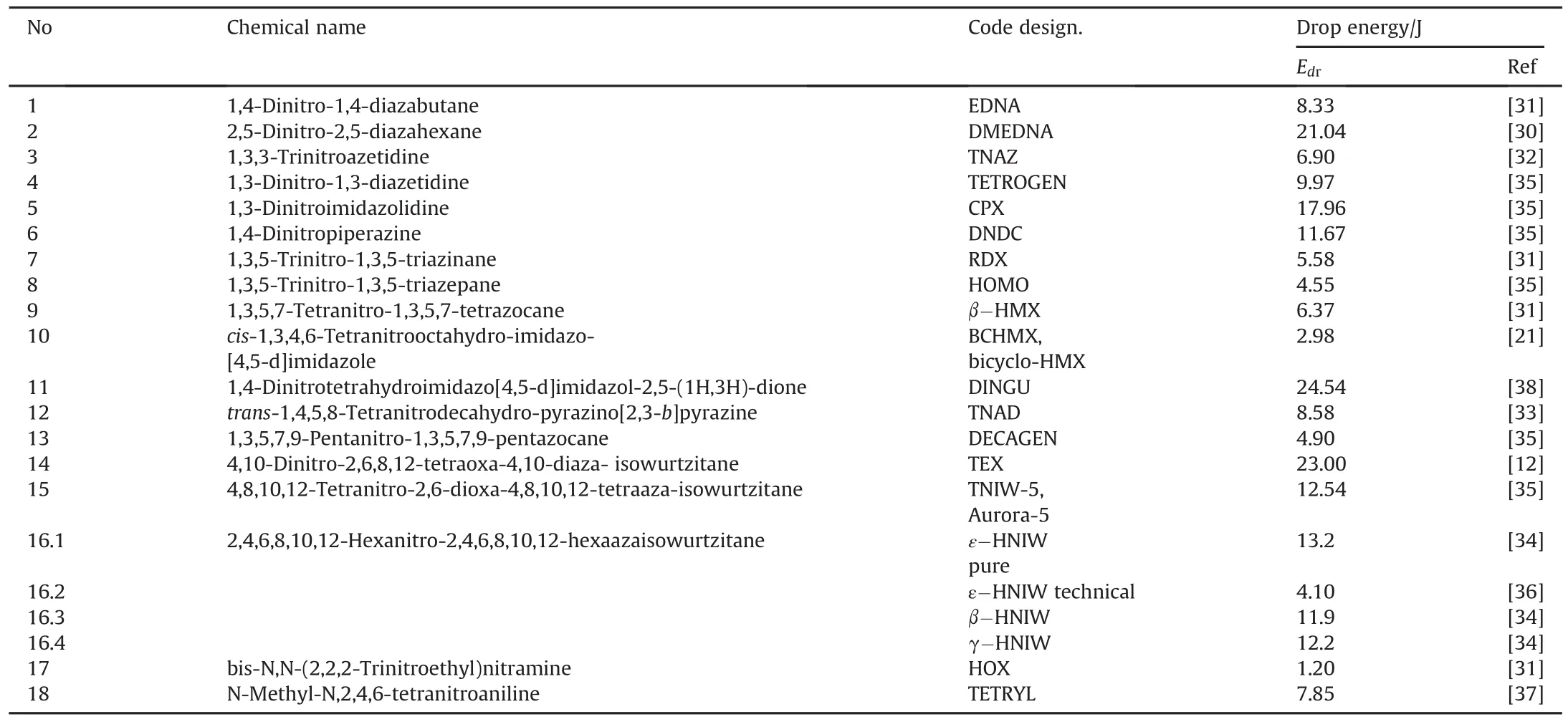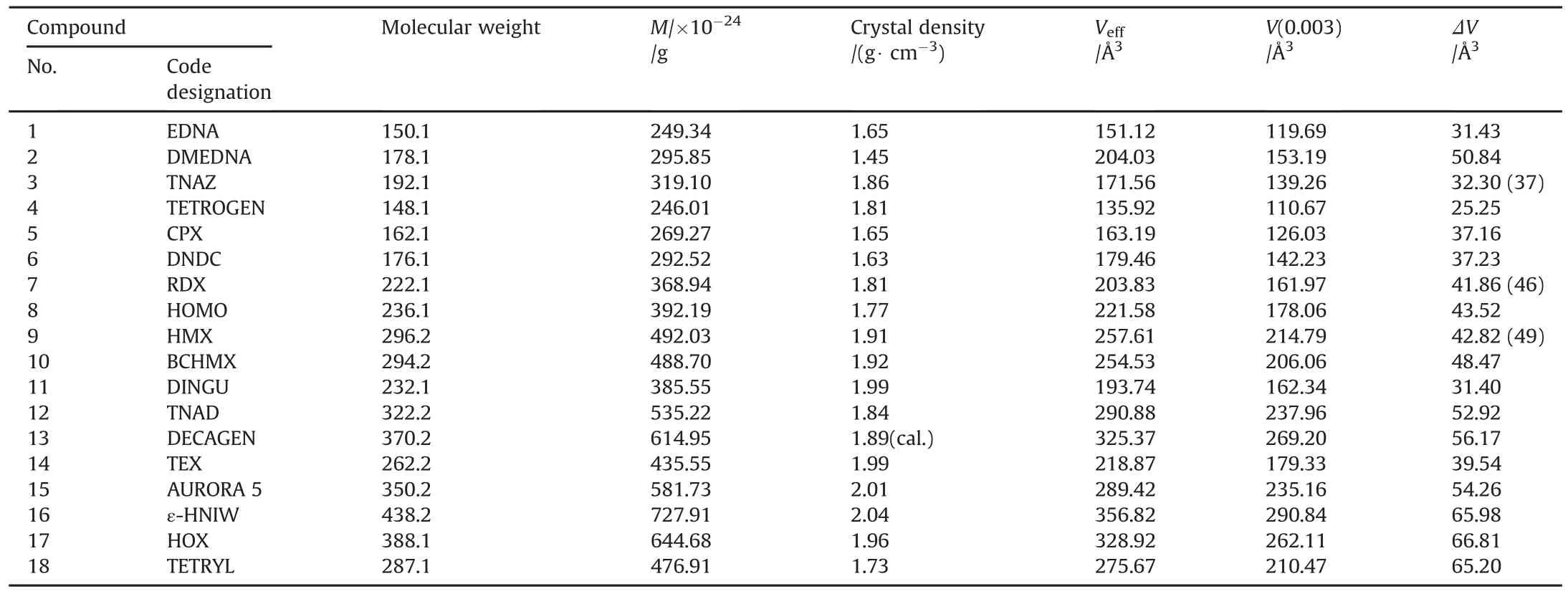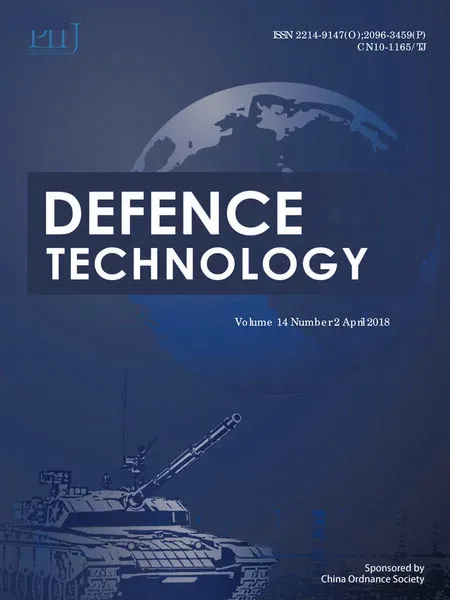Crystal lattice free volume in a study of initiation reactivity of nitramines:Impact sensitivity
Svtopluk Zemn,Ning Liu,Mrel Jungová,Ahmed K.Hussein,Qi-Long Yn
aInstitute of Energetic Materials,Faculty of Chemical Technology,University of Pardubice,CZ-532 10 Pardubice,Czech Republic
bXi'an Modern Chemistry Research Institute,Xi'an,Shaanxi,710065,China
cSchool of Astronautics,Northwestern Polytechnical University,Xi'an 710072 Shaanxi,China
1.Introduction
Sensitivity of energetic materials(EMs)is inherently connected with chemical reactivity of these materials and/or of their components(see for example Refs[1,2]and quotations herein).For that reason it is on the spot heretospeak about initiation reactivity[1,2].As such the reactivity depends on molecular structure and state of matter of the given EM and also on its possible admixtures.By transmission of these facts into one from the most studied reactivity,i.e.into impact sensitivity,we can say that it is a combination of three fundamental sensitivities[3]:molecular,crystalline and environmental.From the point of view of the physical organic chemistry,the first one of these have been extensively studied for individual organic energetic materials(EMs)by means of the NMR chemical shifts of the key atoms in the reaction centers and by means of the modified Evans-Polaniy-Semenov relation(see papers[1,2,4,5]and citations herein);at the same time the crystalline aspects of impact sensitivity were studied by means of heats of fusion for such compounds[1,4].However,intensive application of quantum chemical methods in the study of EMs in general is head and shoulders above the mentioned chemical approach,also in the study of their initiation reactivity[1,2,6-9].The main problem is here that quantum chemical calculations and simulations start from certain opinions held by their authors,and the results correspond to this fact.Relatively often also only several substances are studied or more EMs but with essentially different structures,even though already Politzer and Murray have shown that the correlations found here[10]are restricted to specific classes(i.e.nitroaromatics,nitroheterocycles and nitramines)which is in a perfect conformity with findings from approaches on the basis of physical organic chemistry(see Refs.[1,2,4]and citations herein).Similar restriction can be newly documented also on the basis of application of the free spaces in crystals(FSIC)in a study notonlyof impact but also other kind of the EMs sensitivity;this paper deals with the first one from them.
At these free spaces an attention was aimed[11-15]on the base of very important finding[16,17]which can be verified on the basis of an X-ray crystallographic study of some polynitroarenes[18-20]and of cis-1,3,4,6-tetranitrooctahydroimidazo-[4,5-d]imidazole(BCHMX)[21]:the decisive factors governing the crystal structure particularly of nitramines,are the dipole-dipole interactions of the oxygen and nitrogen atoms of nitro groups in neighboring nitramine molecules in the crystal[16,21-25];A very important finding from the referenced studies,which still needs further investigation,is that non-binding inter-atomic distances between oxygen atoms inside all of the nitro groups in these poly-nitro compounds are shorter than those corresponding to the intermolecular contact radii for oxygen in carbonyl or nitro groups[19-22];this distance is especially short inside the most reactive nitro groups[19-21].These facts have research on free spaces in crystals of EMs and of their in fluence on the EMs impact sensitivity[11-15]but without taking account important molecular-structural similarity[2];therefore,the mentioned papers need some elaboration.This is realized in this paper using extended number of structurally similar compounds.For this purpose a group of nitramines was elected in this paper as energetic materials which in their molecular structure are relatively simple polynitro compounds,and the mechanism of primary homolysis of their molecules is well understood[1,7,26-29].
2.Data sources
2.1.Studied nitramines
Chemical names,code designations and impact sensitivity,expressed as a drop energy(Edr),of the studied nitramines are summarized in Table 1.For a better illustrative nature also structural formulas of these nitramines are presented in Scheme 1.
2.2.Impact sensitivity
The impact sensitivity data of the nitramines studied,shown in Table 1,have been taken from respectable literature[12,21,30-38]:they were obtained by means of a standard impact tester with an exchangeable anvil(Julius Peters),detection of the 50%probability of initiation being based on acoustic detection(Bruceton method)[30-38].The data considered were the drop energies,Edr,obtained by conversion of drop heights values,h50%;it is due to unification of outputs of measurements with different weights of drop hammers.Accuracy of this approach is verified by relationship between logarithm of the Edrvalues and15N NMR chemical shifts of aza nitrogen atoms in reaction centres of the studied nitramines[1,2,4].
2.3.Results of calculation for crystal lattice free volume of nitramine explosives
All of the compounds were optimized at computational level of B3LYP/6-311+g(d,p)by using software Gaussian 09.The crystal volume[V(0.003)]was calculated by using software Multiwfn 3.3.9.The effective volume per molecule(Veff)is calculated as:Veff=M/d,where M is molecular mass,d is crystal density.The intrinsic gas phase molecular volume(Vint)is calculated by the 0.003 au surface according to Ref.[13],Vint=V(0.003).Therefore,the free space per molecule(ΔV)is
Results of these calculations are summarized inTable 2,together with crystal densities of the studied nitramines.
3.Results and discussion
A simple mutual comparing of impact sensitivity(i.e.drop energy,Edr)and the crystal lattice free volume values,ΔV,of the studied nitramines gave a different picture as was shown recently on the 8 nitramines and 17 polynitro compounds of other structures[11-15];according to these papers an increasing of theΔV values should correspond semi-logarithmically to increase,more or less,impact sensitivity.Molecular-structural analysis of the general picture in this paper though does not give like that unambiguous conclusion and leads to Figs.1 and 2 with linear relationships.
Lines with negative slopes in Fig.1 represent groups of nitramines in each from which a similarity of molecular structure plays certainrole.Some exception is line F,grouping structurally different nitramines which,however,might have similar con figuration in their reaction centers,i.e.of nitramino groupings(in HNIW it is inposition 2 which is not planar[34,39]):2,2,2-trinitroethyl groups in the HOX molecule are not mutually equivalent in light of the intermolecular interactions in its crystals[40],a big mutual difference is between steric and inductive effects of the picryl and methyl groups in Tetryl(nitramino group here is not planar,N-methylnitramo group is rotated by 65°out of the benzene ring plane and weak hydrogen bond exists between oxygen atom of nitramino group and hydrogen atom in the position 5 of the benzene ring[41]).Position of data of the technical ε-HNIW in Fig.1 re flects in fluence of its imperfect crystal structure(eventually also of its impurities)on impact sensitivity[2,4]which manifests also in thermal reactivity of different qualitative kinds of this nitramine(big differences in Arrhenius parameters of their thermolysis[42,43]).It all should be due to difference in intermolecularinteractions in imperfect crystal lattice of this kind of HNIW in comparison with its perfect crystal(see in Ref.[34]and partially in[40])-distribution of the actions of force in its crystal lattice as though to remind of those in Aurora 5 and TEX,to which also position of its data at line C corresponds.Crystal structure of this“very sensitive”sort of HNIW needs more detailed study in comparison with its RS(reduced sensitivity[2,36])or chemically pure polymorphs[34].Difference between lines B and C clearly shows in fluence of transition from relatively planar nitramine molecules to their globular analogues.In structures of the nitramines molecules,associated with line D,is possible to find the DMEDNA molecular skeleton.Positions of the HNIW data for all its polymorphic modifications and also of its “normal”quality in Figs.1 and 2 have connection with approach to theΔV values calculation,i.e.by means of eqn.(1),in which optimal con figuration of isolated molecules are take in account.From the same reason a molecular-structural similarity as if has substituted of a real action of the intermolecular forces here.

Table 1A survey of the studied nitramines and their impact sensitivities(Edr).

Table 2A survey of the molecular mass,M,crystal densities,d,intrinsic gas phase volume,Vint,crystal volume,V(0.003)and free space per molecule,ΔV.
Lines with positive slopes in Fig.2 strongly demonstrate molecular structural similarity.Namely line I,by a sign of its slope and also by composition of the corresponding group,is almost identical with those which create exception from semilogarithmic relationship between impact sensitivity and volume heat of explosion[2];in other words this exception is valid also in the case of Fig.2 and it would be needed more detailed quantum chemical analysis.Nevertheless,in the case of lines G and I their trend relates with crossing from planar to the globular molecular systems.Line H unites data of the EDNA derivatives,here crossing from primary to secondary cyclic nitramine DNDC and then to flexible molecule of dimethylated EDNA(i.e.DMEDNA-methyl groups are a good flegmatizing groups).
It is needed to be aware of a possibility that during the impact attack of crystals not only of their compressibility(uniaxial compression)has its share of the given EM decomposition.In dependence on direction of the impact action on main crystal planes also sliding(shear slidewith fixed volume)might have share in initiation:in our recent paper[44]we have intimated relations between impact sensitivity of several nitramine explosives and their bulk(K)and/or shear(G)moduli.But the best ever the relationship for these EMs we found between the mentioned sensitivity and a ratio of these moduli,K.G-1[44]which represents the extent of the plasticity range of the given material(plastic deformations of crystals,together with dislocations,does in the initiation of crystallic energetic materials by the mechanical impulses a decisive role[1,45]).Also here the molecular structural similarity has its in fluence[44].For that matter likewise a semilogarithmic relationship between impact and friction sensitivities of the nitramines is divided into a number of partial relations which are closelycoherent with the molecular-structural characteristics of these compounds[46].Importance and possible principles of the molecular-structural similarity in a study of the EMs sensitivity are mentioned inpaper[2].All so far mentioned facts signalize a higher importance of the intermolecular interactions in a crystal lattice in comparison with importance of the crystal lattice free volume for impact reactivity of the studied energetic materials.This statement perfectly conforms to the already here cited importance of the dipole-dipole interactions of the oxygen and nitrogen atoms of nitro groups in neighboring nitramine molecules for the crystal structure of these nitro compounds[16,21-25].
4.Conclusions
More detailed analysis of a mutual relationship of impact sensitivity(detected by sound)and crystal lattice free volume,ΔV,for the 18 nitramines shows that increase of theΔV values corresponds to enhance of this sensitivity but also fairly big number of nitramines are here inwhich the relationship works in the opposite direction;this opposite character is mainly connected with transition from approximately plane molecular structures to the globular ones.Especially,a direction of the mentioned relationship for data of1,3,5-trinitro-1,3,5-triazinane,1,3,5,7-tetranitro-1,3,5,7-tetrazocane,and β- and ε-polymorphs of 2,4,6,8,10,12-hexanitro-2,4,6,8,10,12-hexaazaisowurtzitane is similar like those which create exception from semilogarithmic relationship between impact sensitivity and volume heat of explosion[2].Initiation reactivity of technical ε-polymorphs of 2,4,6,8,10,12-hexanitro-2,4,6,8,10,12-hexaazaisowurtzitane(i.e.position of its data in Figs.1 and 2 and in other similar reference frame[2])gives the impression by disorderliness in distribution of the actions of force in its crystal lattice in comparison with its RS-ε-HNIW or chemically pure analogue.Also limitations of partial shapes of the mentioned relationship by molecular-structural similarity signalizes higher importance of the intermolecular interactions in a crystal lattice in comparison with the crystal lattice free volume for initiation of the crystallineEMsbymechanicalimpulses(seeforexample[1,4,30,46]and references herein).These problems,however,need further investigation.
Acknowledgement
The work described in this paper partially received financial support from the Students Grant Projects No.SGSFCHT_2016002 of the Faculty of Chemical Technology at the University of Pardubice,partially it was created in the framework of the six month traineeship of Dr.LIU Ning in Institute of Energetic Materials at University of Pardubice in 2016 under financial support The State Administration of Foreign Experts Affairs,Peoples Republic of China.
Appendix A.Supplementary data
Supplementary data related to this article can be found at https://doi.org/10.1016/j.dt.2017.11.008.
[1]Zeman S.Sensitivities of high energy compounds.In:Klapoetke T,editor.High energy density compounds,structure&bonding,vol.125.Heidelberg,Germany:Springer;2007.p.195-271.
[2]Zeman S,Jungova M.Sensitivity and performance of energetic materials.Propellants,Explos Pyrotech 2016;41(3):426-51.
[3]Delpuech A,Cherville J.Relation entre la structure electronique et la sensibilit′e au choc des explosifs secondaries nitr′es.Critˋere moleculaire de sensibilit′e.I.Propellants,Explos 1978;3:169-75.
[4]Zeman S.Study of the initiation reactivity of energetic materials.Chapter 8.In:Armstrong RW,Short JM,Kavetsky RA,Anand DK,editors.Energetics science and technology in central Europe,Maryland:CECDS.College Park:University of Maryland;2012.p.131-67.
[5]Zeman S,Yan Q-L,Elbeih A.Recent advances in the study of the initiation of energetic materials using the characteristics of their thermal decomposition Part II.Using simple differential thermal analysis.Central Eur J Energetic Mater 2014;11(3):395-404.
[6]Zhang C.Review of the establishment of nitro charge method and its application.J Hazard Mater 2009;161:21-8.
[7]Kuklja MM.Quantum-chemical modeling of energetic materials:chemical reactions tiggered by defects,deformations,and electronic excitations.In:Sabin JR,editor.Advances in quantum chemistry,energetic aterials,book series:advances in quantum chemistry,vol.69.Burlington:Academic Press;2014.p.71-145.
[8]Politzer P,Murray JS.Some molecular-crystalline factors that affect the sensitivities of energetic materials:molecular surface electrostatic potentials,lattice free space and maximum heat of detonation per unit volume.J Mol Model 2015;21:1-11.
[9]Murray JS,Politzer P.The electrostatic potential:an overview.WIREs Comput Mol Sci 2011;1:153-63.
[10]Politzer P,Murray JS.Sensitivity correlations.In:Politzer P,Murray J,editors.Theoretical and computational chemistry.Energetic materials,Part 2,detonation,combustion,vol.13.Amsterdam:Elsevier BV;2003.p.5.
[13]Politzer P,Murray JS.Impact sensitivity and crystal lattice compressibility/free space.J Mol Model 2014;20:2223.https://doi.org/10.1007/s00894-014-2223-7.
[14]Politzer P,Murray JS.Some Molecular-crystalline factors that affect the sensitivities of energetic materials:molecular surface electrostatic potentials,lattice free space and maximum heat of detonation per unit volume.J Mol Model 2015;21:1-11.
[15]Politzer P,Murray JS.High performance,low sensitivity:conflicting or compatible?Propellants,Explos Pyrotech 2016;41(3):414-25.
[16]Atovmyan LO,Golovina NI,Zolotoy AB,Zhitomirskaya NG,Fedorov BS,Eremenko LT.Structure and packing of primary and secondary nitro amines.Zhurnal Organicheskoy Khimii 1998;24(9):1848.
[17]Eckhardt CJ,Gavezzotti A.Computer simulations and analysis of structural and energetic features of some crystalline energetic materials.J Phys Chem B 2007;111:3430-7.
[18]Roháč M,Zeman S,Ržička A.Crystallography of 2,2’,4,4’,6,6’-hexanitro-1,1’-biphenyl and its relation to initiation reactivity.Chem Mater 2008;20:3105-9.
[19]Zeman S,Roháč M,Friedl Z,Ržička A,Lyčka A.Crystallography and structureproperty relationships of2,2’’,4,4’,4’’,6,6’,6’’-octanitro-1,1’:3’,1’’-terphenyl(ONT).Propellants,Explos Pyrotech 2010;35:130-5.
[20]Zeman S,Roháč M,Friedl Z,Ržička A,Lyčka A.Crystallography and structurepropertyrelationshipsin 2,2’,2’’,2’’’,4,4’,4’’,4’’’,6,6’,6’’,6’’’-dodecanitro-1,1’,:3’,1’’:3’’,1’’’-quaterphenyl(DODECA).Propellants,Explos Pyrotech 2010;35:339-46.
[21]Klasovitý D,Zeman S,Ržička A,Jungová M,Roháč M.cis-1,3,4,6 Tetranitrooctahydroimidazo-[4,5-d]imidazole(BCHMX),its properties and initiation reactivity.J Hazard Mater 2009;164:954-61.
[22]Krebs B,Mandt J,Cobbledick RE,Small RWH.The structure of N,N-dimethylnitramine.Acta Crystallogr 1979;B35:402-4.
[23]Filhol A,Bravic G,Rey-Lafon M,Thomas M.X-ray and neutron studies of a displacive phase transition in N,N-dimethylnitramine(DMN).Acta Crystallogr 1980;B36:575.
[24]Turley JW.A re finement of the crystal structure of N,N-dinitroethylenediamine.Acta Crystallogr 1968;B24:942-6.
[25]Goncharov TK,Aliev ZG,Aldoshin SM,Dashko DV,Vasil‘eva AA,Shishov NI,et al.Preparation,structure,and main properties of bimolecular crystals CL_20-DNP and CL_20-DNG.Russ Chem Bull Int Ed 2015;64(2):366-74.
[26]Dubovitskii FI,Korsoonskii BL.Kinetika termicheskogo razlozheniya N-nitrosoedinenii(Kinetics of thermal decomposition of N-nitrocompounds).Uspekhi Khimii 1981;50:1828.
[27]Nazin GM,Manelis GB.Thermal decomposition of aliphatic nitrocompounds.Russ Chem Rev 1994;63:313.
[28]Cook M.Thermal decomposition of RDX:a critical review.J Energetic Mater 1987;5:257.
[29]Manelis GB,Nazin GM,Rubtsov YuI,Strunin V.Thermal Decomposition and Combustion of Explosives and Propellants.London and New York:Taylor&Francis;2003.
[30]Jungová M,Zeman S,Husarová A.Friction sensitivity of nitramines.Part I:comparison with impact sensitivity and heat of fusion.Chin J Energetic Matrerials(HanNeng CaiLiao)2011;19(6):603-6.
[31]Storm CB,Stine JR,Kramer JF.In:Bulusu SN,editor.Chemistry and physics of energetic materials.Dordrecht:Kluwer Acad Publs;1990.p.605.
[32]Simpson RI,Garza RG,Foltz MF,Ornellas DI,Utriev PA.Characterization of TNAZ.Rep.UCRL-ID-119572.Laewrence Livermore Lab.;1994.
[33]Willer RL.Synthesis and characterization of high-energy compounds.I.trans-1,4,5,8-Tetranitro-1,4,5,8-tetraazadecalin (TNAD).Propellants,Explosives,-Pyrotechnics 1983;8:65-9.
[34]Ou Y,Wang C,Pan Z,Chen B.Sensitivity of hexanitrohexaazaisowurtzitane.Chin J Energetic Mater(HanNeng CaiLiao)1999;7:100-8.
[35]Atalar T,Jungová M,Zeman S.A new view of relationships of the N-N bond dissociation energiesof cyclic nitramines.Part II.Relationships with impact sensitivity.J Energetic Mater 2009;27(3):200-16.
[36]Elbeih A,Husarová A,Zeman S.Path to ε-HNIW with reduced impact sensitivity.Central Eur J Energetic Mater 2011;8(3):173-83.
[37]Kamlet MJ,Adolph H.The relationship of impact sensitivity with structure of organic high explosives.Part II.Polynitroaromatic explosives.Propellants,Explos 1979;4:30-4.
[38]Storm CB,Stine JR,Kramer JF.Sensitivity relationships in energetic materials.In:Bulusu SN,editor.Chemistry and physics of energetic materials.Dordrecht:Kluwer Acad Publs;1990.p.605-39.
[39]Gatilov YuV,RybalovaTV,E fimov OA,LobanovaAA,Sakovich GV,Sysolyatin SV.Molecular and crystal structure of polyciclyc nitramines.J Struct Chem 2005;46(3):566-71.
[40]Atovmyan LO,Gafurov RG,Golovina NI,Eremenko LT,Fedorov BS.Crystal and molecular structure of two modifications of bis(2,2,2-trinitrioethyl)nitramine.Zhurnal Strukt Khimii 1980;21(6):135-41.
[41]Cady HH.The crystal structure of N-methyl-N,2,4,6-tetranitroaniline(Tetryl).Acta Crystallogr 1967;23(4):601-9.
[42]Zeman S,Friedl Z,Bartoková M,Yan Q-L.Comparison with molecular surface electrostatic potential and thermal reactivity of nitramines.Chin J Energetic Mater(HanNeng CaiLiao)2015;23(12):1155-61.
[43]Zeman S,Yan Q-L,Vlček M.Recent advances in the study of the initiation of energetic materials using characteristics of their thermal decomposition Part I.Cyclic nitramines.Central Eur J Energetic Mater 2014;11(2):173-89.
[44]Zeman S,Jungová M,Yan Q-L.Impact sensitivity in respect of the crystal lattice free volume and the characteristics of plasticity of some nitramine explosives.Chin J Energetic Mater(HanNeng CaiLiao)2015;11(12):1186-91.
[45]Coffey CS.Initiation due to plastic deformation from shock or impact.In:Politzer P,Murray J,editors.Theoretical and computational chemistry.Energetic materials,Part 2,detonation,combustion.Amsterdam:Elsevier BV;2003.p.101.
[46]Zeman S,Krupka M.New aspects of impact reactivity of polynitro compounds.Part III.Impact sensitivity as a function of the intermolecular interactions.Propellants,Explos,Pyrotech 2003;28(06):301-7.
- Defence Technology的其它文章
- Evaluating location specific strain rates,temperatures,and accumulated strains in friction welds through microstructure modeling
- The effects of compressibility and strength on penetration of long rod and jet
- A DFT study on TNGU isomers and aluminized cis-TNGU composites
- Numerical simulation and optimized design of cased telescoped ammunition interior ballistic
- The kinetic of mass loss of grades A and B of melted TNT by isothermal and non-isothermal gravimetric methods
- Crystal lattice free volume in a study of initiation reactivity of nitramines:Friction sensitivity

